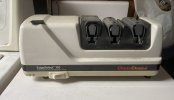I watched a video of a guy dressing and butchering a buffalo in a different historically correct way...with rocks. He had killed it with a stick and a rock, too, in a very expert way.
Around 2000 I took 3 semi-free-roaming bison (escaped from a ranch the spring before): one with a spear-thrower, one with sinew-backed bow, one with a cut-down Brown Bess. In field-dressing and processing I compared repro tools based on artifacts recovered from some kill sites in the area with an original "I Wilson" butcher.
If you make the initial cut and from there work from the inside, skinning a recently-wallowed cow with a stone tool isn't much of a problem (once you wrap the stone "handle" with a clump of the longer hair from the neck, otherwise the fluids make the tool slick). WIth a little re-touching I could skin with one or two tools. Bone tools were a solid "fail" cutting the hide, with the edge quickly lost. Steel required frequent re-touches for the same amount of work in hide covered with dried mud.
Processing was another matter. Here the bone tools were great: the very coarse "toothy" edge and longer blade made boning and cutting the meat go much faster than the shorter stone tool. The advantages of steel were that it didn't require importing the stone for tools, and that it could be sharpened in less time than making and grinding a bone tool. I'd have to dig out my notes to be sure, but as I recall the steel knife was about 50% quicker than bone when slicing the meat for drying. All in all it was an interesting project.
As for older steels, I'm still working on that. I've gathered bog iron and refined it in a bloomery, worked it into wrought iron, made blister steel and forged that into shear steel and double-shear steel, and experimented with crucible steel. I'm one the fence with the crucible steel; my wrought isn't refined enough to match the stuff from Sweden that Huntsman was using. My end results (carbon content) aren't as consistent with the crucible steel as I get with the double-shear steel. OTOH, there are no slag stringers in the crucible steel.
Still working on the test blades. I'm working on copies of a knife (actually several) recovered from a village that was occupied around 1780-1795. The knives are of the French pattern but that late were probably English-made. In that period, British trade knives would have been double-shear steel at best, which is consistent with the one original blade (a surface find from the area) that was sacrificed for analysis.
As for Tomme Boy's question about older steels, I wonder if the issue isn't that back then once they had optimized their refinement and heat-treating they focused on perfecting the form for the intended purpose. Today, similar tools seem to lack the same refinement in form and function, probably because we don't use them with the same intensity. I have smoothing planes that are wonderful--far better than most of the modern offerings--but today we are more likely to use an electric planer or wide-belt sander with the same end goal in mind.



